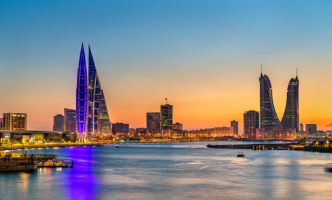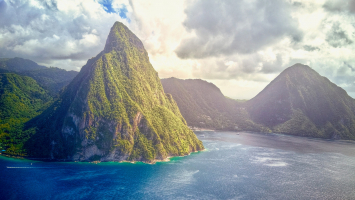Top 10 Unique Cultural Characteristics of Bangladesh
Bangladesh's culture is reflected in the way of life of its citizens. The nation has a rich cultural diversity that has developed over time as a result of ... read more...influences from many social groupings. Islam, Buddhism, and Hinduism, Bangladesh's three main religions, have had a significant impact on the culture of the nation. During the Bengal Renaissance in the 19th and early 20th centuries, the development of Bengali culture flourished, with notable Bengali authors, scientists, filmmakers, singers, artists, and researchers playing a crucial role. The nation's dancing, music, literature, architecture, and even clothes all reflect this culture. Here are some unique cultural characteristics of Bangladesh.
-
Terracotta sculptures created in the area in the third century BCE are the earliest evidence of art in Bangladesh. In classical antiquity, the Pala Empire and the Sena dynasty produced noteworthy Hindu, Jain, and Buddhist sculptures. The development of Islamic art began in the 14th century. The Bengal Sultanate's architecture included distinctive dome-shaped mosques without minarets that had intricate niche pillars. The weaving of Jamdani designs on fine muslin was the most renowned artistic practice of Mughal Bengal, and it is today recognized by UNESCO as an intangible cultural asset. Jamdani motifs were comparable to both Western and Iranian (buta) textile art (paisley). The imperial court in Dhaka supported the Jamdani weavers. Mughal art also made extensive use of ivory and brass. Bengali culture makes extensive use of pottery.
The groundbreaking works by Zainul Abedin played a major role in the development of the modern art movement in Bangladesh throughout the 1950s. Unlike the West Bengali art groups, East Bengal established its own modernist painting and sculpture traditions. The Art Institute Dhaka has been an important institution for visual art in the region. In 2016, UNESCO added the annual Bengali New Year parade to its list of intangible cultural heritage. Sculptors Novera Ahmed and Nitun Kundu were among the nation's first practitioners of modernism. In recent years, photography has gained popularity as a kind of art. The twice-yearly Chobi Mela is regarded as Asia's biggest photographic festival.
globaltimes.cn 
globaltimes.cn -
Folk, classical, and modern are the three main subcategories of music and dance in Bangladesh. Traditional folk songs from the nation are replete with love-related topics. The nation's culture, mysticism, and spirituality are reflected in the lyrics. The lyricists for some of the folk songs, such as Hason Raja and Abbas Uddin, include Baul, Murshidi, and Bhatiali.
Although some dance traditions, like Kathak and Bharatnatyam, exhibit influences from other regions of the Indian subcontinent because Bangladesh was formerly a part of Pakistan, the dancing styles of Bangladesh are distinctive. Rock bands with western cultural influences are becoming more and more well-liked in the cities. In Bangladesh, both contemporary instruments with western roots, including guitars, and traditional instruments, like bamboo flutes and drums called bashi and tabla or dhol, are utilized for music.
There are many different types of theater in Bangladesh, and it has existed there since the fourth century CE. Narrative forms, song and dance performances, supra-personae performances, scroll painting performances, puppet theater, and processional forms are all included. Bengali folk theater is well-known for its data. Bangladesh's dance traditions include traditional tribal and Bengali dances as well as Kathak, Odissi, and Manipuri dances, which are classical Indian dances. It is one of the unique cultural characteristics of Bangladesh.
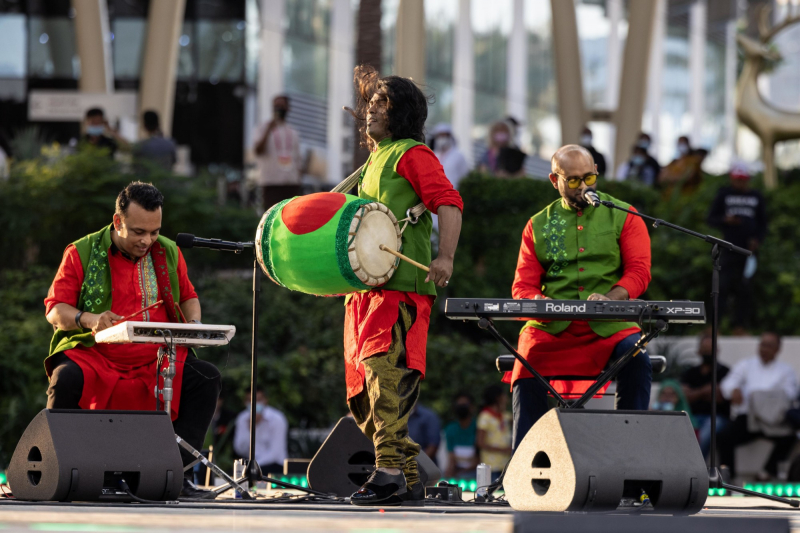
virtualexpodubai.com 
virtualexpodubai.com -
The Mahasthan Brahmi Inscription, which originates from the third century BCE, is the earliest example of writing found in Bangladesh. Sanskrit literature flourished in the Gupta Empire. Between the eighth and tenth centuries, Bengali originated from Sanskrit and Magadhi Prakrit. Bengali literature has a 2,000-year history, and the Charyapadas are among the genre's earliest instances of poetry.
Many Bengali Muslim writers were influenced by Sufi spiritualism. Arabic and Persian literature influenced Bengali writers of the Middle Ages under the Bengal Sultanate. Bengali literature was valued by the Bengali sultans. The writings of Maladhar Basu, Bipradas Pipilai, Vijay Gupta, and Yasoraj Khan are a few examples. The prominent lyric poets of the early Middle Ages are known as the Chandidas. The bard of middle Bengali literature was Syed Algol.
Modern Bengali writing, such as novels, short tales, and science fiction, is influenced by the Bengal Renaissance. The Bengali Shakespeare, Rabindranath Tagore, was the first non-European recipient of the Nobel Prize in Literature. A revolutionary poet who advocated for a political uprising against fascism and colonialism was Kazi Nazrul Islam. Begum Rokeya is regarded as Bangladesh's first feminist author. Michael Madhusudan Dutt and Sarat Chandra Chattopadhyay were two other renaissance figures. The Bengali author Syed Mujtaba Ali is renowned for his international outlook. A well-known pastoral poet was Jasimuddin. Considered two of the greatest Bengali poets to have appeared in the 20th century are Shamsur Rahman and Al Mahmud. The most significant thinker to emerge from Bangladesh after independence is Ahmed Sofa. Popular science fiction and magical realism authors in modern Bangladesh include Humayun Ahmed.

tripadvisor.com 
tripadvisor.com -
However, a number of women held significant political positions in Bangladesh as of 2015. Its women are still subjected to a patriarchal social structure where violence is prevalent. In Bangladesh, women are more likely to work as their education level rises, whereas in India and Pakistan, this trend is the opposite. Feminist activism in Bengal has a long history that dates to the 19th century. Before the country was divided, Begum Rokeya and Faizunnessa Chowdhurani were crucial in promoting girls' education and emancipating Bengali Muslim women from purdah. During the British Raj, a number of women were elected to the Bengal Legislative Assembly. Begum, the first women's magazine, came out in 1948.
Bangladeshi women made about 26% of the labor force in 2008. The majority of blue-collar employment in Bangladesh's garment sector are held by women. While female employment in white collar sectors has progressively expanded, Bangladeshi women still hold significant occupations in agriculture, social services, healthcare, and education.
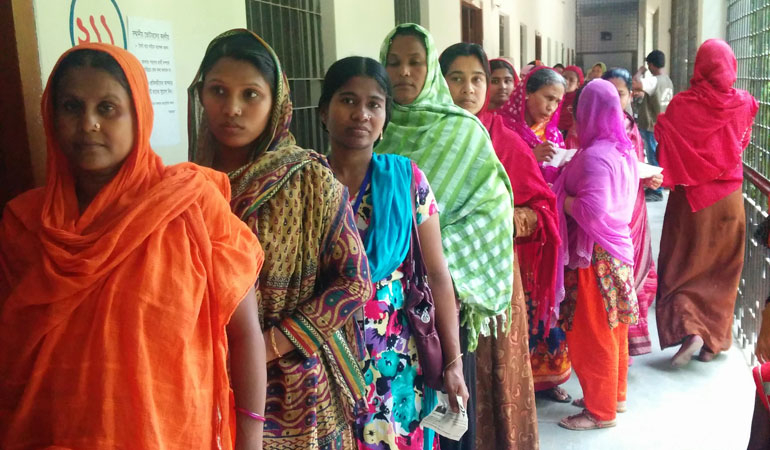
usaid.gov 
usaid.gov -
Bangladesh's architectural traditions have a 2,500-year history. Bengal is known for its distinctive terracotta architecture. The Pala Empire saw the height of pre-Islamic Bengali architecture as the Pala School of Sculptural Art built impressive buildings like the Somapura Mahavihara. Islamic architecture first emerged under the Bengal Sultanate, when the construction of medieval mosques was influenced by regional terracotta designs. It is one of the most unique cultures, customs, and traditions in Bangladesh.
The Sixty Dome Mosque is a superb example of Turkic-Bengali architecture and was the largest medieval mosque ever constructed in Bangladesh. When Bengal was made a province of the Mughal Empire, the local architecture was superseded by the Mughal style, which also had an impact on the construction of urban housing. Excellent examples of late-medieval Hindu temple building include the Kantajew Temple and the Dhakeshwari Temple. During the British era, Indo-Saracenic Revival architecture, based on Indo-Islamic designs, flourished. Many Indo-Saracenic palaces and country homes, including the Ahsan Manzil, Tajhat Palace, Dighapatia Palace, Puthia Rajbari, and Natore Rajbari, were constructed in Bangladesh by the zamindar nobility. The bungalow was invented by Bengali vernacular architecture. Bangladeshi villages are made out of mud, straw, wood, and bamboo buildings with thatched roofs. Village homes are increasingly fashioned of tin in recent times.
The first modern architect in Bangladesh was Muzharul Islam. His numerous creations shaped the nation's modern architectural practice. Islam encouraged eminent international architects to work in what was now East Pakistan, including Louis Kahn, Richard Neutra, Stanley Tigerman, Paul Rudolph, Robert Boughey, and Konstantinos Doxiadis. The National Parliament Complex in Sher-e-Bangla Nagar was designed by Louis Kahn. One of the great works of the 20th century is considered to be Kahn's massive designs, which combine the aesthetics of local red brick with his own concrete and marble brutalism and the use of lakes to symbolize Bengali geography. Award-winning architects like Rafiq Azam have changed the direction of modern architecture in more recent years by incorporating elements from Ibn Kahn and Islam's works.
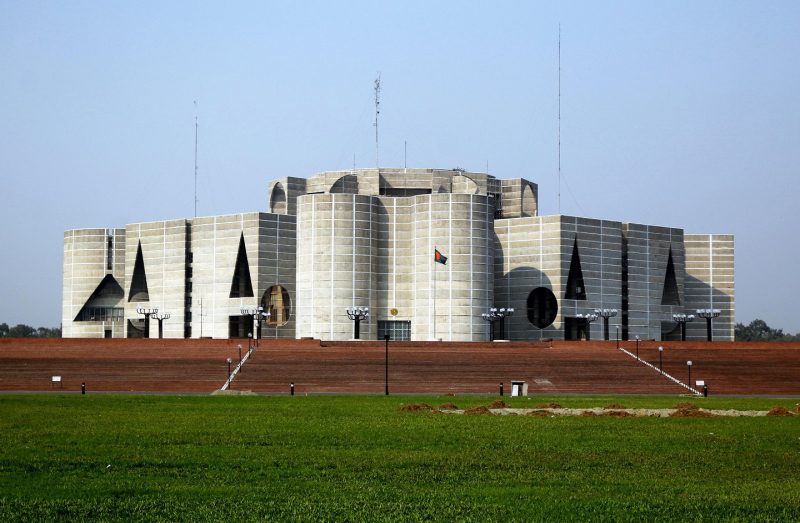
npr.org 
npr.org -
The Nakshi Kantha is a centuries-old quilt embroidery technique that is thought to have originated in eastern Bengal (i.e., Bangladesh). The sari is the traditional clothing for women in Bangladesh. The best Muslin saris, as well as the renowned Dhakai and Jamdani, whose weaving is classified by UNESCO as one of the pinnacles of humanity's intangible cultural heritage, were produced in Mughal Dhaka. Rajshahi silk is also produced in Bangladesh. Bangladeshi women also frequently don the shalwar kameez.
Some women can be spotted wearing western attire in urban areas. The lungi and dhoti are the men of Bangladesh's everyday wear; the kurta and sherwani are their traditional attire. Men in the nation typically dress in locally designed suits and neckties at offices, schools, and on social occasions, in addition to ethnic clothing. It is one of the unique cultural characteristics in Bangladesh.
60–65% of the nation's clothing needs are met by the handloom sector. The Bengali ethnic apparel market has thrived in the ever-changing fashion landscape. One of the most popular ethnic clothing brands in South Asia is the shop Aarong. Modern Western clothing is now produced and sold locally thanks to the growth of Bangladesh's textile sector, which supplies top international brands. Today, the nation boasts a variety of growing regional brands, including Westecs and Yellow. Bangladesh is the second-largest exporter of clothing worldwide. Bibi Russell, a fashion designer from Bangladesh, has won praise abroad for her "Fashion for Development" runway displays.
thecorporatereview.com 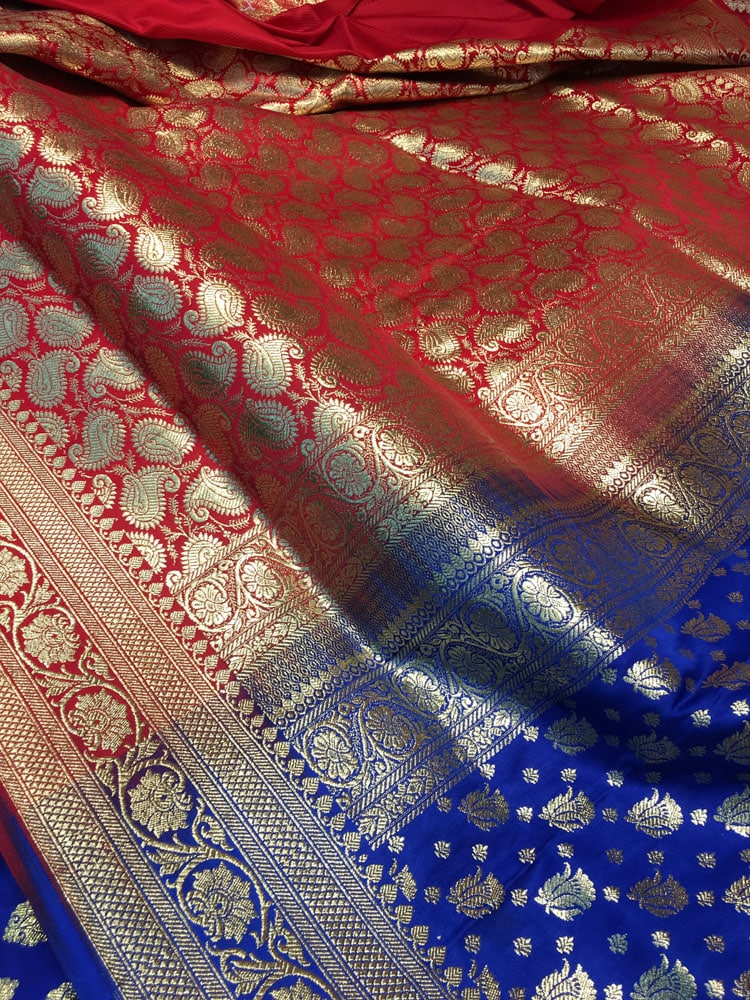
thecorporatereview.com -
Bangladesh has unusual dress preferences. Lungis are the preferred informal attire for Bangladeshi males in rural areas, while suits or shirts and trousers are the preferred formal attire. For cultural and religious occasions, men wear traditional clothing known as Panjabi. Young girls also wear salwar kameez, but the sari is the traditional and predominant clothing for ladies. It is one of the unique cultural characteristics of Bangladesh.
Bangladesh and the nearby Indian state of West Bengal have similar culinary histories. But there are several differences between the two areas. Meat consumption is higher in Bangladesh, which has a plurality of Muslims, whereas vegetarianism is more common in West Bengal, which has a majority of Hindus. In many Western nations, especially the UK, the Bangladeshi diaspora dominates the South Asian restaurant market.
Along with a variety of vegetables and lentils, white rice is a cornerstone of Bangladeshi cuisine. Bengali pulaos, khichuris, and biryanis are further rice dishes. In Bangladeshi cuisine, ingredients such as fruit chutneys, ghee, mustard sauce, and sunflower oil are frequently utilized. Bengali cuisine's primary source of protein is fish. Bangladesh's national fish, the hilsa, is incredibly well-liked there. Rohu, butterfish, catfish, tilapia, and barramundi are a few other kinds of fish that are consumed. Fish eggs are a specialty food. Bengali cuisine emphasizes seafood, particularly lobster, shrimp, and dried fish. Chicken, beef, mutton, venison, duck, and squab are among the meats eaten. Mezban feasts are a well-known tradition in Chittagong, where spicy beef curry is served. Shatkora lemons are used to marinate food in Sylhet. The boiling of bamboo shoots is common among the indigenous Hill Tracts.
A wide variety of desserts are available in Bangladesh, including tasty treats like Rôshogolla, Rôshomalai, Chomchom, Mishti Doi, and Kalojaam. Traditional rice-or fruit-based boiling desserts are known as pithas. When there are religious celebrations, halwa is served. The primary local bread includes naan, paratha, luchi, and bakarkhani. As a welcome gesture, milk tea is given to visitors and is the most popular hot beverage in the nation. In Bangladesh, kebabs are very well-liked, especially seekh kebabs, chicken tikka, and shashliks.

ontaheen.com 
ontaheen.com -
The Bengali new year, or Pahela Baishakh, is the largest event in Bengali culture and is celebrated widely. Only Pahela Baishakh, one of the major holidays observed in Bangladesh, is devoid of any pre-existing expectations (such as a particular religious identity or gift-giving tradition) and has evolved into a time to honor Bengal's simpler, rural roots. The Bengali harvest festivals of Nabonno and Poush Parbon are among other cultural celebrations.
The national holidays in Bangladesh are the Muslim festivals of Eid al-Fitr, Eid al-Adha, Milad un Nabi, Muharram, Chand Raat, and Shab-e-Barat; the Hindu festivals of Durga Puja, Janmashtami, and Rath Yatra; the Buddhist festival of Buddha Purnima, which commemorates the birth of Gautama Buddha; and the Christian festival of Christmas. The two Eids are observed with a string of long-lasting public holidays, giving city inhabitants the chance to celebrate the holidays with their families outside of the city.
Alongside are national holidays like Independence Day, Victory Day, and Language Movement Day (21 February 1952), which was commemorated as International Mother Language Day by UNESCO in 1999. People gather in Dhaka's Shaheed Minar on Language Movement Day to honor the national leaders of the Bengali Language Movement. On Independence Day and Victory Day, similar rallies are held at the National Martyrs' Memorial to honor the national heroes of the Bangladesh Liberation War.The history and customs of Bangladesh are honored on these special days through public ceremonies, parades, citizen rallies, political speeches, fairs, concerts, and a variety of other public and private events. Radio and TV stations play patriotic music and special programs. Fairs, festivals, and concerts are frequently organized by schools and universities and are attended by members of Bangladeshi society at all social strata.

iexplore.com 
iexplore.com -
Several traditional indigenous sports, including Kabaddi, Boli Khela, Lathi Khela, and Nouka Baich, are still reasonably well-liked in rural Bangladesh. Although Kabaddi is the national sport, cricket and football are the two most played sports in the nation. In 1999, the national cricket team competed in their first Cricket World Cup, and the status as a Test cricket team was awarded the following year. Bangladesh reached the quarterfinals of the 2015 Cricket World Cup, the semifinals of the 2017 ICC Champions Trophy, and the Asia Cup final three times between 2012 and 2018 (as well as the quarterfinals of the 2014 and 2015 tournaments). The men's Under-19 Cricket World Cup was held in South Africa in February 2020, and it was won by the Bangladeshi youth national cricket team. Bangladesh's first World Cup triumph was this one.
In Bangladesh, women's sports made great advancements during the 2010s decade. The 2018 Women's Twenty20 Asia Cup was won by the Bangladesh women's national cricket team, which defeated India in the championship match.
Along with cricket, football is a popular sport in Bangladesh, and it is overseen by the Bangladesh Football Federation (BFF). Football competitions are often held in and around Dhaka, and every FIFA World Cup brings the nation to its feet. During the 1971 Liberation War, the Shadhin Bangla Football Team became the first national football team representing Bangladesh. Zakaria Pintoo, the captain of the Shadhin Bangla football team, was the first person to raise the Bangladesh flag outside of Bangladeshi territory. The national squad was only the second South Asian team to compete in the 1980 AFC Asian Cup. The Bangladesh women's national football squad, particularly the Under-15 and Under-18 sides, has also experienced considerable success at the regional level.
espn.com 
espn.com -
Islam is designated as the "state religion of the Republic" under Article of the Bangladeshi Constitution, which also recognizes freedom of religion and declares Bangladesh to be a secular state. More than 91 percent of people identify as Muslims. Bengali Muslims, the second-largest Muslim ethnoreligious community in the world after the Arabs, make up the majority of the population of Bangladesh. Another minority of Muslims are not Bengali. Muslims in Bangladesh are predominantly Sunni, with minority of Shia and Ahmadiya. Non-religious Muslims make up about 4% of the population. Bangladesh is the third-largest country with a majority of Muslims and has the fourth-largest Muslim population in the world (after Indonesia and Pakistan). In the area, sufism has a rich history.
Orthodox movements and liberal Bengali Islam can collide. The annual Bishwa Ijtema, hosted by the traditional Tablighi Jamaat, is the largest gathering of Muslims in Bangladesh. After the Hajj, the Ijtema is the largest gathering of Muslims anywhere in the world. The Islamic Foundation is an independent government organization in charge of various religious matters under state supervision, such as observing moon sightings in line with the lunar Islamic calendar to determine the dates of festivals and upholding the zakat custom of almsgiving.
reuters.com 
reuters.com

















